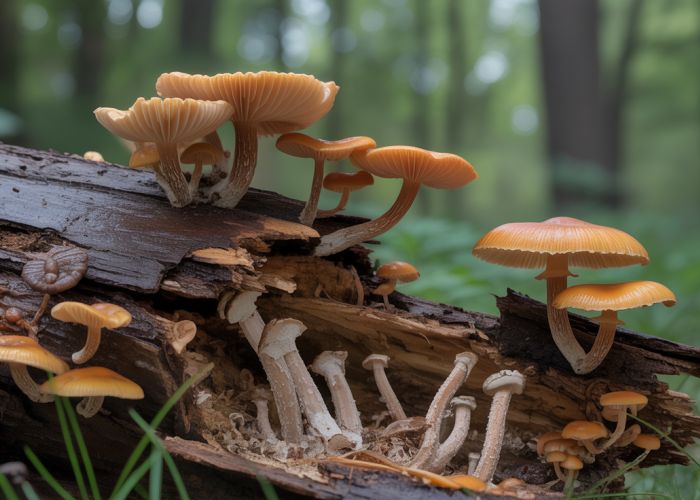Ecosystems rely on the intricate balance of energy flow, and decomposition plays a pivotal role. Heterotrophs, the organisms that cannot produce their own food, obtain sustenance by consuming other organic matter. This process of consumption and breakdown means that heterotrophs release simple substances like carbon dioxide and water. The role of fungi in this decomposition showcases how heterotrophs release simple substances, enabling the recycling of nutrients back into the environment for use by producers.

Unlocking the Powerhouse: How Heterotrophs Release Simple Substances
This article explores how heterotrophs, organisms that cannot produce their own food, acquire energy and contribute significantly to global ecosystems. We will focus on the process by which "heterotrophs release simple substances," examining its mechanisms, importance, and broader implications.
Understanding Heterotrophs: The Consumers of Life
Heterotrophs represent a vast group of organisms, ranging from microscopic bacteria to towering elephants. Their defining characteristic is their reliance on external sources for nutrition. This makes them crucial players in energy flow and nutrient cycling.
What defines a Heterotroph?
- Dependence on Others: Heterotrophs obtain energy by consuming organic compounds produced by other organisms, whether living or dead.
- Diversity of Diet: They exhibit incredible dietary diversity, encompassing herbivores (plant eaters), carnivores (meat eaters), omnivores (eat both plants and meat), and decomposers (break down dead organic matter).
- Essential Role in Ecosystems: Their feeding habits directly influence the population dynamics and nutrient availability within their environments.
The Process: Heterotrophs Digest and Release
A key process related to heterotrophs is that "heterotrophs release simple substances". This happens through a series of steps involving digestion and metabolism.
Digestion: Breaking Down the Complex
Digestion is the initial phase where complex organic molecules are broken down into simpler, absorbable units.
- Ingestion: Taking in food through various mechanisms (e.g., eating, absorbing).
- Mechanical Breakdown: Physically reducing food size (e.g., chewing, churning in the stomach).
- Chemical Breakdown: Using enzymes to break down large molecules like carbohydrates, proteins, and fats into smaller molecules such as glucose, amino acids, and fatty acids.
Metabolism: Using and Releasing
Once digested, the simple substances are absorbed and enter metabolic pathways. This is where energy is extracted and waste products are generated.
- Cellular Respiration: Glucose is broken down to produce energy (ATP), releasing carbon dioxide (CO2) and water (H2O) as byproducts.
- Waste Product Formation: Other metabolic processes generate various waste products, including nitrogenous compounds (e.g., ammonia, urea, uric acid) depending on the organism and its environment.
Examples of Simple Substances Released
Heterotrophs release a range of simple substances, each playing a crucial role in the environment.
| Substance | Source (Process) | Environmental Impact |
|---|---|---|
| Carbon Dioxide | Cellular Respiration | Greenhouse gas; essential for photosynthesis |
| Water | Cellular Respiration | Important for hydration and other biological processes |
| Ammonia | Protein Metabolism | Nutrient for plants; can contribute to eutrophication |
| Urea | Protein Metabolism | Converted to ammonia; nutrient for plants |
| Methane | Anaerobic Digestion | Potent greenhouse gas |
The Significance: Powering Ecosystems
The release of simple substances by heterotrophs has far-reaching consequences for the entire ecosystem.
Nutrient Cycling: Returning Essential Elements
- Decomposers, a type of heterotroph, play a vital role in breaking down dead organic matter and releasing nutrients back into the soil.
- This process is essential for plant growth, as it provides them with the necessary minerals and elements.
- The released nutrients also support the growth of other microorganisms, contributing to a complex and dynamic food web.
Global Carbon Cycle: A Balancing Act
- Heterotrophs consume organic carbon and release carbon dioxide through respiration, contributing to the global carbon cycle.
- Their activities influence the concentration of carbon dioxide in the atmosphere, which has implications for climate change.
- Understanding the role of heterotrophs in the carbon cycle is crucial for developing strategies to mitigate climate change.
Ecosystem Stability: Maintaining Balance
- The activity of heterotrophs, including their role in "heterotrophs release simple substances," impacts the stability and health of ecosystems.
- By controlling populations of other organisms and recycling nutrients, they help maintain a balance in the environment.
- Disruptions to heterotrophic communities can have cascading effects throughout the entire ecosystem.
Heterotrophs’ Simple Secrets: FAQ
Heterotrophs are vital to life as we know it. Here are some common questions and concise answers to help you understand their role and importance in powering our world.
What exactly does it mean to be a heterotroph?
A heterotroph is an organism that cannot produce its own food. Instead, it obtains energy and nutrients by consuming other organic matter, like plants or animals. Think of humans, animals, fungi, and many bacteria – they all rely on external sources for sustenance.
How do heterotrophs get energy from what they eat?
Through digestion and respiration, heterotrophs break down complex organic molecules into simpler ones. This process releases energy that the heterotroph can use for growth, movement, and other life functions. Heterotrophs release simple substances like carbon dioxide and water as byproducts.
Why are heterotrophs important for the environment?
Heterotrophs play a crucial role in nutrient cycling. By consuming organic matter, they help decompose dead organisms and waste products. This releases essential nutrients back into the environment, making them available for plants (autotrophs) and other organisms.
What’s the main difference between heterotrophs and autotrophs?
The primary difference is their food source. Autotrophs, like plants, produce their own food using sunlight, water, and carbon dioxide through photosynthesis. Heterotrophs, on the other hand, depend on consuming autotrophs or other heterotrophs to obtain energy. Through respiration, heterotrophs release simple substances back into the atmosphere or soil.
So, that’s the scoop on how heterotrophs release simple substances and keep our world ticking! Pretty cool, right? Thanks for diving in with us!



